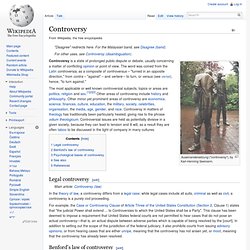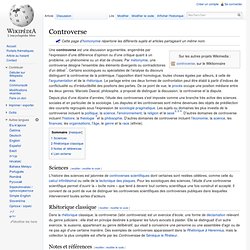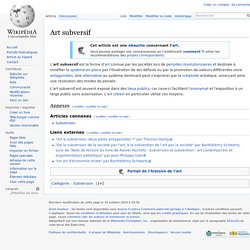

Conspiracy theory. A conspiracy theory is an explanatory proposition that accuses two or more persons, a group, or an organization of having caused or covered up, through secret planning and deliberate action, an illegal or harmful event or situation.[1][2][3] Some scholars suggest that people formulate conspiracy theories to explain, for example, power relations in social groups and the existence of evil forces.[4][5][6][7] It has been suggested by some thinkers that conspiracy theories have chiefly psychological or socio-political origins.

Proposed psychological origins include projection; the personal need to explain “a significant event [with] a significant cause;" and the product of various kinds and stages of thought disorder, such as paranoid disposition, ranging in severity to diagnosable mental illnesses. Similarly, socio-political origins may be discovered in the need of people to believe in event causation rather than suffer the insecurity of a random world and universe.[8][9][10][11][12][13] The 31 Wildest Conspiracy Theories - Photo Gallery. 7 Conspiracy Theories That Turned Out To Be True. I like things that really stretch the limits of what you know to be true. Whether these are documentaries, talks or books, I like it all. It makes you realize that there is so much more to reality that you may think, and that any thing is really possible if you keep an open mind.
Many people tend to see conspiracy theories as something wacky and never having any ties to reality, but sometimes if you look deeply enough into something you may find there’s more to it than what you’ve been told. Here are 7 conspiracy theories which have been proven true, and shows you the measure of what “governments” will do to get what they want. Operation Snow White – 1970s 1Operation Snow White was the Church of Scientology’s internal name for a major criminal conspiracy during the 1970s to purge unfavorable records about Scientology and its founder L. Link Gulf of Tonkin incident – 1964 2On August 2, 1964, three North Vietnamese torpedo boats attacked a US destroyer, the USS Maddox. Link. The 911 Best Evidence Panel. Jean Ziegler. ProCon.org - Pros and Cons of Controversial Issues. Debates and analysis of current affairs.
Mapping Controversies. Alain Soral. Controversial Bookstore. Fringe theory. Category:Fringe theory. Category:Pseudoscience. Pseudoscience is a broad group of theories or assertions about the natural world that claim or appear to be scientific, but that are not accepted as scientific by the scientific community.

Pseudoscience does not include most obsolete scientific or medical theories (see Category:Obsolete scientific theories), nor does it include every idea that currently lacks sufficient scientific evidence (e.g. String theory) This category comprises well-known topics that are generally considered pseudoscientific by the scientific community (such as astrology) and topics that have very few followers and are obviously pseudoscientific (such as the modern belief in a flat Earth). The pejorative term itself is contested by various groups for various reasons. Generally speaking, if an article belongs in this category, the article's lead will contain a well-sourced statement that the subject is considered pseudoscience.
Subcategories This category has the following 25 subcategories, out of 25 total. Michel Collon. Controversy. Auseinandersetzung ("controversy"), by Karl-Henning Seemann.

Controversy is a state of prolonged public dispute or debate, usually concerning a matter of conflicting opinion or point of view. The word was coined from the Latin controversia, as a composite of controversus – "turned in an opposite direction," from contra – "against" – and vertere – to turn, or versus (see verse), hence, "to turn against. " Legal controversy[edit] For example, the Case or Controversy Clause of Article Three of the United States Constitution (Section 2, Clause 1) states that "the judicial Power shall extend ... to Controversies to which the United States shall be a Party". List of controversial issues. You may also be looking for Wikipedia:Controversial articles.

This is a list of Wikipedia articles deemed controversial because they are constantly being re-edited in a circular manner, or are otherwise the focus of edit warring. This page is conceived as a location for articles that regularly become biased and need to be fixed, or articles that were once the subject of an NPOV dispute and are likely to suffer future disputes. Other articles not yet classified as "controversial" have some edit conflict issues. The divisive nature of disputed subjects have triggered arguments, since opinions on a given issue differ.
Controverse. Un article de Wikipédia, l'encyclopédie libre.

Cette page d’homonymie répertorie les différents sujets et articles partageant un même nom. Sur les autres projets Wikimedia : controverse, sur le Wiktionnaire. Pierre Carles. Category:Controversies. List of books banned by governments.
Art subversif. Un article de Wikipédia, l'encyclopédie libre.

L'art subversif est souvent exposé dans des lieux publics, car ceux-ci facilitent l'anonymat et l'exposition à un large public sans autorisation. L'art urbain en particulier utilise ces moyens. Articles connexes[modifier | modifier le code] Subversion. Subversion. Un article de Wikipédia, l'encyclopédie libre.

La subversion (latin subvertere : renverser) désigne un processus par lequel les valeurs et principes d'un système en place, sont contredits ou renversés. Le discrédit et la chute du pouvoir établi se fait dans le cadre de territoires politiquement ou militairement convoités[1]. Conspiracy of Science - Earth is in fact growing The Earth is Expanding. THE PANGEA THEORY is wrong . Yet it’s still the generally accepted one; still taught in our schools.
In this video Neal Adams explains the theory that the Earth is in fact growing. If you have ever looked at a map of the world , you have undoubtedly noticed that the East coast of South America appears to mimic the shape of the West coast of Africa. This observation was also noticed by German born geophysicists, Alfred Wegener, who proposed that the continents we see today were once connected. His theory ( Kontinentalverschiebung ) was ridiculed and dismissed for 40 years because no one could imagine how continents could move and essentially plow through the ocean floor’s crust. But in the 1950s a research ship of the Lamont-Doherty Earth Observatory of Columbia University, conducted a deep sea survey of the Atlantic Ocean’s floor and discovered an enormous submerged mountain chain which they named the “Mid-Atlantic Ridge”. Catégorie:Controverse. Michel Onfray.